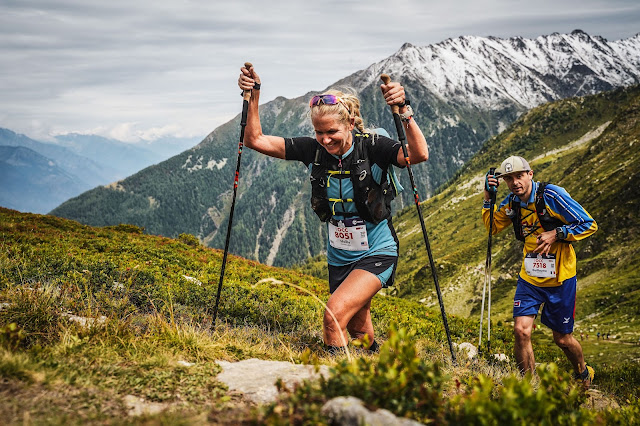Base Training: Not Just For Endurance Runners
 Back in late fall 2016, as I was
contemplating my race calendar for the upcoming year, I shared my thoughts with my coach and
he said, “Sounds good. That gives us time for three months of base
training.”
Back in late fall 2016, as I was
contemplating my race calendar for the upcoming year, I shared my thoughts with my coach and
he said, “Sounds good. That gives us time for three months of base
training.”
What exactly is base training? And how
important is it?
Base training could principally be described as ‘training to
train, not training to race.’ It is a period used to strengthen the muscular
and aerobic systems and get the body prepared for the greater stresses that are
applied when training to race. The goal of base training is to develop a runner’s
aerobic potential to its maximum before implementing anaerobic training, which fine-tunes
the body to run at greater speed.
 |
| Cross-country skiing is a great aerobic exercise |
 |
| TRX (Source: Club Solutions Magazine) |
Once the aerobic system is developed to
its maximum, then four to six weeks of anaerobic training can follow prior to
racing. More than six weeks of anaerobic training is counterproductive because
improvements reach a point of diminishing returns and introduces the risk of
burnout (lowering of blood pH).
 Nevertheless, base training is more than
just a lot of easy running. This is also an ideal time to work on strength training
when it isn’t interfering with other high-intensity or speed workouts. Of
course this doesn’t mean you should head to the gym for some heavy
weightlifting, but working those supporting muscles that help you to keep your
running form all the way to the finish line can be beneficial. For me this
means a lot of functional exercises that target core muscles in the abdomen and
back, which include variations of the standard push-up, lunges, and squats and
may use aids such as a kettlebell, suspension (TRX), resistance training with
latex bands (TheraBand), and exercise balls. These exercises are all about
proper form, so it may be a good idea to have a specialist walk you through them
first. I’ve had several sessions with physical trainer Christian Wolf
(yourbodyisyourmachine.de) and within a very short time found myself surprisingly
happy with the results. Stability on the trails in an ultra distance mountain
race is, in my opinion, nearly as important as endurance.
Nevertheless, base training is more than
just a lot of easy running. This is also an ideal time to work on strength training
when it isn’t interfering with other high-intensity or speed workouts. Of
course this doesn’t mean you should head to the gym for some heavy
weightlifting, but working those supporting muscles that help you to keep your
running form all the way to the finish line can be beneficial. For me this
means a lot of functional exercises that target core muscles in the abdomen and
back, which include variations of the standard push-up, lunges, and squats and
may use aids such as a kettlebell, suspension (TRX), resistance training with
latex bands (TheraBand), and exercise balls. These exercises are all about
proper form, so it may be a good idea to have a specialist walk you through them
first. I’ve had several sessions with physical trainer Christian Wolf
(yourbodyisyourmachine.de) and within a very short time found myself surprisingly
happy with the results. Stability on the trails in an ultra distance mountain
race is, in my opinion, nearly as important as endurance.
One thing I love about base training is
that running is more about ‘time on my feet’ rather than distance covered, so I
go “off-road”, sometimes following the deer trails through the woods in deep
snow, jumping over shrubs and ducking under the low branches. This keeps the
fun in running. A win-win.
 |
| 'Off-road' with Leni the Lab |
But can base training help short- and
middle-distance runners too? You bet! Whether you are an 800-meter specialist
or marathon runner, you can benefit by maximizing your steady-state level prior
to anaerobic training. As so poignantly stated by the athlete and coach Chris
Hauth, “The prize never goes to the fastest guy. It goes to the guy who slows
down the least.”
For more information on Base Training
check out the books: Running with Lydiard
by Garth Gilmour and Arthur Lydiard (the godfather of athletic coaching); The Lore of Running by Dr. Tim Noakes;
or Daniels’ Running Formula by Dr.
Jack Daniels….three of my favorites.




Comments
Post a Comment